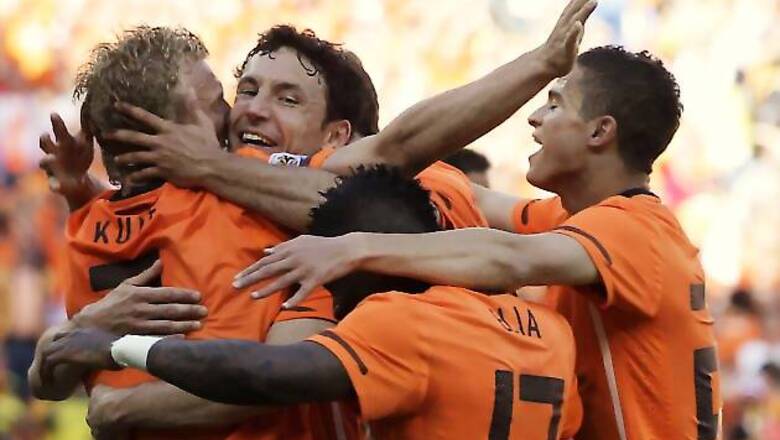
views
Johannesburg: Some of the biggest names in world football will grace Sunday's World Cup final, but will Xavi Hernandez, Andres Iniesta, Arjen Robben and Robin van Persie turn on the style or be shackled by a safety-first desire to bring the title home for the first time?
Netherlands coach Bert van Marwijk said his team has buried the happy-go-lucky style of play that thrilled fans for 40 years. Instead of the free-flowing moves of Johan Cruyff, there's tight discipline, an emphasis on possession — and careful buildup from the back. The tactics have brought criticism, but also results: The Dutch unbeaten streak is now up to 25 games, including 10 straight wins.
The same could be said to some extent for Spain. The team has yet to truly light up the World Cup, losing to Switzerland and struggling to get past lesser teams. Xavi and Iniesta raised their game for the 1-0 semifinal win over Germany with the intricate passing and movement — a Barcelona trademark. But the European champions seem more driven by a collective desire to win rather than shine individually.
Here's a look at both teams, and the tactics they may adopt on Sunday at Soccer City:
THE NETHERLANDS
Defense
The Netherlands plays a flat back four in front of tall Ajax goalkeeper Maarten Stekelenburg. Stekelenburg's one-handed save against Kaka in the quarterfinal win over Brazil is one of the best of the tournament, but his blunder on Diego Forlan's equalizer in the semifinals also stands out.
In front of him, John Heitinga and Joris Mathijsen are expected to play in the center on Sunday. Heitinga's pace and tackling complement the strength and aerial prowess of Mathijsen. Captain Giovanni van Bronckhorst will be at left back and 22-year-old Gregory van der Wiel on the right. Both know how to make probing runs on the wings.
Considered the biggest liability coming into the World Cup, the backline has proven to be a sound foundation, if not impregnable.
Van Marwijk, however, counts on everyone to contribute. Even the forwards.
"You have to work together when the opponent has the ball and then you can go a long way," Van Marwijk said.
Midfield
Van Marwijk will field defensive midfielders Mark van Bommel and Nigel de Jong to reinforce the defense.
Van Bommel has had a sterling season with Bayern Munich and has used the same mix of grit and intimidation to lead the team. De Jong is stockier, a tireless tackler whose job is to break up opposition attacks.
Their work gives both Robben and Dirk Kuyt freedom on the flanks. Kuyt's work rate stands out and contrasts with Robben's flashes of brilliance as he cuts inside from the right, passes defenders and shoots from long range.
Robben was the star of Bayern Munich's run to the Champions League final and missed the two opening games because of a hamstring strain that still continues to bother him during play.
Attack
Van Persie recovered from an ankle injury that had blighted his club season just in time to lead the Netherlands' attack at the World Cup. He has stuttered in South Africa with just one goal in six appearances. Playmaker Wesley Sneijder has glossed over that deficiency by scoring five goals from his deeper position. It turned him into the star of the team and he is joint leader of the scoring chart with five goals.
SPAIN
Defense
Barcelona center back Carles Puyol is a rugged fighter, but also a threat at set-pieces. It was his powerful header from a corner that put Spain into the final, and he marshals a backline of goalkeeper Iker Casillas, Sergio Ramos, Barcelona teammate Gerard Pique and Joan Capdevilla. The defense soaked up Germany's attacks and rarely looked threatened and gives the team a solid backbone. They have the collective ability to neutralize individual threats, as they did with Cristiano Ronaldo in the second-round match with Portugal. They're likely to adopt the same tactics against Sneijder.
Midfield
Iniesta and Xavi have what seems to be a telepathic understanding and can wear teams down with their intricate passing patterns. When on form, frustrated opponents are forced to chase the game and often struggle to get hold of the ball. They can suddenly switch gear and probe opposition defenses in the safe knowledge that midfielder Xabi Alonso is behind them, breaking up opposition attacks and launching Spanish moves from deep. If Spain coach Vicente del Bosque needs a Plan B, he has Cesc Fabregas to call on from the bench.
Attack
David Villa is joint top scorer with Sneijder with five goals. The Barcelona-bound striker is a classic poacher but has proved lethal from distance, too, scoring an opportunistic goal from 45 meters (yards) against Chile in the group stage. Fernando Torres has had a disappointing tournament, looks drained of confidence and lost his place in the starting lineup in the semifinals. Yet when on form, Torres is among the best in the world and he scored the only goal in the 2008 European Championship final against Germany. Whether to play Torres or Pedro Rodriguez, who played in the semifinals and at times tormented the German defenders with his quick dribbling and pace, is probably the major tactical decision Del Bosque must take.




















Comments
0 comment